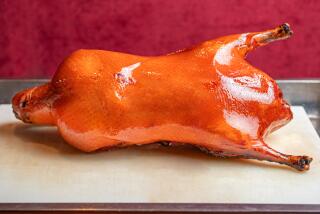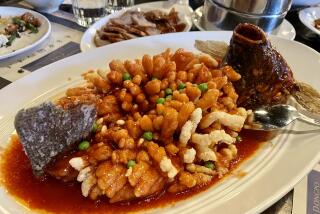Home Peking
- Share via
Transforming a raw duckling into a roasted Peking duck involves several steps and takes up the better part of a day.
None of the maneuvers is particularly difficult, but after reading this, you may decide that your fingers would be put to better use calling a Chinese restaurant and making a reservation.
To do the job yourself, you need to find a whole duck. Chinatown butchers or poultry farms are the best bet, but you may be able to order one through other butchers. Ask only that a small slit be made in the neck and that the oil sacs be removed from the tail.
The skin of a Peking duck becomes crisp because air between it and the meat allows space for the fat to melt and drip out during roasting. You make this air space by massaging the duck’s body, then carefully running your fingers between the skin and meat.
Once the skin is loosened, the tail cavity of the duck is sewn tightly closed so no air can escape. A straw or bamboo tube is inserted down the neck between the skin and body, and the duck is inflated like a balloon by blowing air through the straw.
To make the skin taut, boiling water is poured over the duck. Then it’s painted with a marinade, which adds rich coloring as the duck is dried, then roasted.
You can use a clothes hanger to hang the duck by inserting the sharp end into the duck’s neck and stretching the triangular part into a long, narrow diamond shape that will fit over a hook.
Find a cool, well-ventilated place to hang the duck to dry. An electric fan directed toward the duck will speed the process.
Once the duck is dried, the head can be removed if desired. Place the duck on a rack and roast in the oven until deep golden brown.
Pieces of Peking duck crackling skin are traditionally served wrapped in Chinese thin crepe-like pancakes (available in Asian markets) or doughier fist-sized dumpling-like buns. Green onion frills (the white and barely pale green ends shredded like party favors) are used to brush on a little hoisin sauce before the pancakes are folded up.
The meat from the duck can be added to the pancake packages or served as a separate course with some stir-fried vegetables.
captions:
1
Leave the duck’s head intact, but use a cleaver to remove the feet and wing tips.
2
From the tail cavity, gently run your fingers between the skin and meat, being careful not to puncture the skin.
3
Use a darning needle and string to sew the tail cavity tightly closed.
4
Insert a straw between the skin and meat and tie a string loosely around the neck so you can tighten it when the straw is removed.
5
Insert a hook through the neck bone above the string and hang the duck in a cool, well-ventilated place.
6
After roasting to deep golden brown, use a sharp knife to remove the crisp skin from the duck.
PEKING DUCK
1 (5- to 6-pound) whole duck
Water
1/2 cup red wine vinegar
1/4 cup honey
Thoroughly wash duck inside and out with cold running water. Remove any excess fat from cavity. Pat dry with paper towels.
With sharp cleaver, cut off feet below drumsticks and wing tips at first joint (Step 1). Discard.
Loosen skin from meat by gently massaging entire body. Beginning at tail end, run fingers between skin and meat, being careful not to puncture skin (Step 2). Insert fingers into neck opening and loosen skin over breast in same manner.
Using darning needle and fine string, sew tail cavity tightly closed (Step 3). Insert straw or bamboo tube down neck between skin and meat. Tie string loosely around neck, ready to tighten when straw is removed (Step 4).
Blow air into duck, gently rubbing skin to allow air to enter. When duck is inflated, remove straw quickly, pulling string tight to keep air from escaping and tie securely.
Place duck, breast side up, on cutting board in sink. Pour boiling water over duck, turn and scald other side. Repeat procedure second time. Pat duck dry with paper towels.
Combine vinegar, 1 cup water and honey. Brush duck with mixture, making sure all sides are coated with marinade.
Insert hook through neck bone above string (Step 5). Hang duck in cool, well-ventilated place 8 to 10 hours. Place pan underneath to catch drippings.
Preheat oven to 400 degrees. Remove duck head if desired. Place duck, breast side down, on rack in roasting pan.
Place duck in oven and reduce heat to 350 degrees. Roast 15 minutes, then turn duck breast side up and continue roasting until skin is deep golden brown, about 1 hour.
Remove duck from oven. Lifting from head end, pierce tail cavity and allow fat and juices to run out. With sharp knife slice off skin (Step 6). When as much skin as possible has been removed, carve meat.
4 to 6 servings. Each of 6 servings:
503 calories; 72 mg sodium; 86 mg cholesterol; 45 grams fat; 13 grams carbohydrates; 13 grams protein; 0 fiber.
More to Read
Eat your way across L.A.
Get our weekly Tasting Notes newsletter for reviews, news and more.
You may occasionally receive promotional content from the Los Angeles Times.









